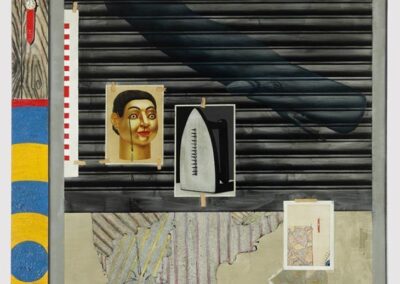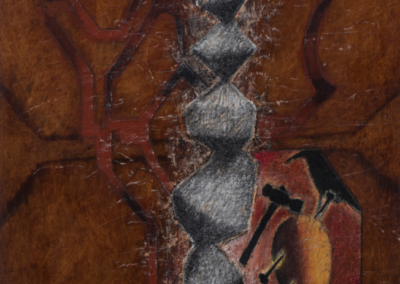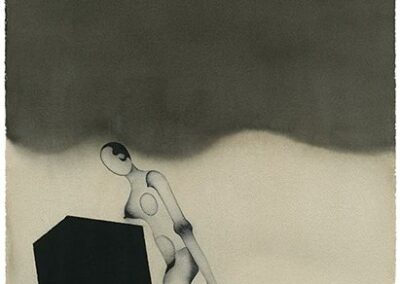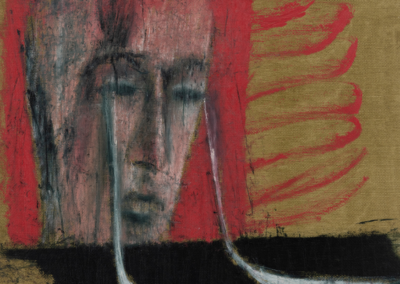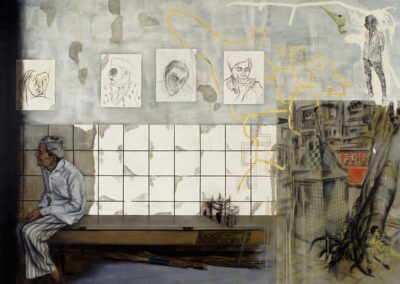Our next Artist You Need To Know is Atul Dodiya.
He is regarded as one of India’s most important and most acclaimed artists after India’s independence from British colonial rule : Dodiya has never been easily categorized and is often cosmopolitan in his approach, attempting to reconcile historical references (both in the Indian cultural sphere and beyond) to have relevance in a contemporary context of both art and society.
Synthesis is an element of his work, as he pulls from political discourse as well as Bollywood and art historical references that are both Indian and international. Dodiya “refuses to confine himself to a box neatly labelled with a national identity; his location in India serves him as a base from which to intervene in a variety of cultural and political histories to which the postcolonial self is heir.” (from here)
Dodiya works in a wide variety of media, though usually in paint, but over his career he has produced works in a more ‘photo realist’ style, but also has employed metal shutters as ‘canvases’ (which are some of his better known works).
Born in Mumbai (when it was still known as Bombay), India, in 1959, Dodiya’s family was originally from the west coast section of the country (Kathiawar in Gujarat) but had relocated to the metropolis of Mumbai before he was born.
Dodiya earned a BFA from the Sir J. J. School of Art in Mumbai and would further his studies at the École des Beaux-Arts in Paris (1991 to 1992), having been awarded a scholarship by the French government to continue his studies.
He has exhibited primarily in India but also internationally. Significant shows in India include Reflections and Images at Vadehra Art Gallery (New Delhi and Mumbai, 1993) and Trends and Images (CIMA, Calcutta, 1993). On the international stage, Dodiya has shown his work at Gallery Lund (Amsterdam, 1993), as well as being included in The Richness of the Spirit (Kuwait and Rome in 1986–89), India – Contemporary Art (World Trade Center (Amsterdam, 1989), and Exposition Collective (Cité Internationale Des Arts, Paris, 1992). Dodiya was also one of the artists that represented India at the Venice Biennale in 2019.
From here : “…Dodiya revitalized the painted surface by responding to the challenges posed by new mediatic structure such as satellite television and the internet on the one hand, and by new artistic modes such as video, assemblage and installation on the other. He began to construct his paintings as argument, allegories, riddles, or aphorisms. In so re-engineering the machinery of the painting, he brought a gamut of unpredictable and mutually unrelated energies to bear on pictorial space: his corpus of references soon grew to include poems, comic strips, traders’ lists of wares, advertising billboards, movie posters, cinema stills, popular religious oleographs, and streetside graffiti, as well as his favorite paintings from the postcolonial Indian, Mughal, European and American traditions By 1999, Dodiya’s transformation was complete. He was far more readily identified with a flamboyantly hybrid idiom in which the distinctions between classical and demotic, regional and international, beaux arts and popular culture, had not simply been blurred but actively broken down in the interests of a fictive, sparking, idiosyncratic collage of impulses.”
Dodiya has been the recipient of a number of awards, including the Government of Maharashtra Gold Medal (1982), the Sanskriti Award (New Delhi, 1995), the Sotheby’s Prize (1999), the Civitella Ranieri Foundation Fellowship (Italy, 1999) and the Raza Award, from the Raza Foundation (2008).
His artworks can be found in collections both in India and around the world, such as the Centre Pompidou (Paris, France), Detroit Institute of Arts (Detroit, USA), Deutche Bank (India), Devi Art Foundation (Gurgaon, India), Fukuoka Asian Art Museum (Japan), Guggenheim Abu Dhabi (Abu Dhabi, UEA), Tate Modern (London, UK) and the Herwitz Collection, Peabody Essex Museum (Salem, USA).
A more complete list of both Dodiya’s exhibition record and private and public collections which hold Dodiya’s art can be explored here.
Atul Dodiya is married to Anju Dodiya (who is a significant artist as well) and lives and works in Mumbai.
Like many artists, Dodiya is also a social historian. Critic Mustansir Dalvi (writing about Dodiya’s 2023 exhibition Dr Banerjee in Dr Kulkarni’s Nursing Home and other paintings 2020-2022) offered that the artist’s works have “become an unintended, but welcome, archive of the lost years between independence and liberalisation presented through the documentation of objects that once populated homes.”
Much more about Dodiya’s life – awards and exhibitions, as well as several videos offering the artist’s ideas about his work – can be enjoyed here at his site. More of his artworks can be seen here, as well.







